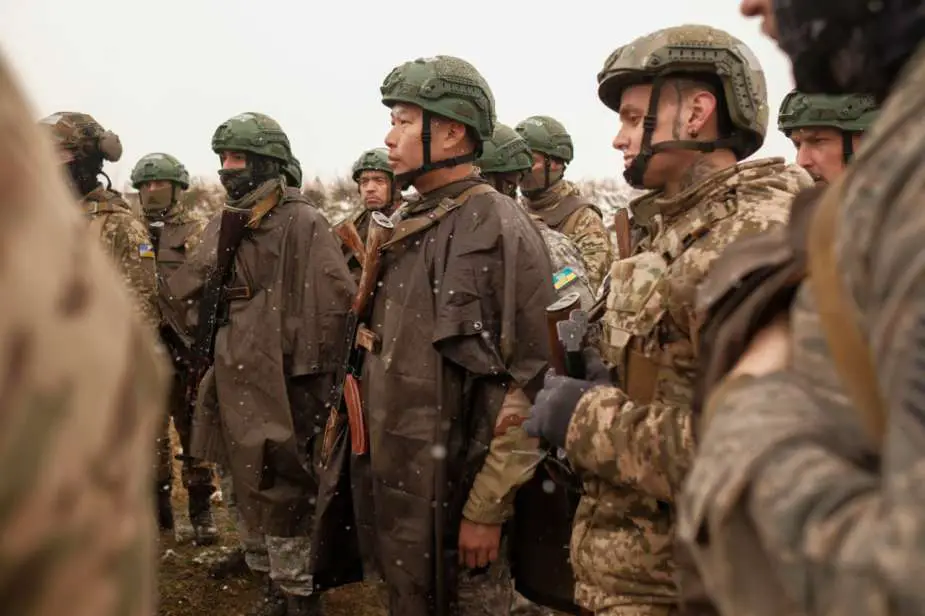The human resources challenge for Ukraine and Russia in 2024
The impact of human resources on the conflict in Ukraine in 2024 reveals several key aspects, including Ukraine's ambition to mobilize 500,000 men, the challenges encountered in achieving this goal, the Russian response, and the growing involvement of unmanned technologies in the conflict. The ability to deploy a significant number of soldiers on the battlefield remains an important factor in 2024, and we will delve into more detail on this aspect of the conflict.
Follow Army Recognition on Google News at this link

International Legion for the Defense of Ukraine (Picture source: Ukrainian MoD)
Facing the Russian invasion, Ukraine sought to strengthen its defense by mobilizing a considerable force of 500,000 men. However, this ambition faces several major obstacles. First, the human and material resources required for such mobilization are immense, and Ukraine is already dealing with high casualty rates and potential labor shortages. Additionally, dependence on international aid, particularly from the United States and the EU, is a critical factor, with aid commitments encountering significant political obstacles.
For Ukraine, the mobilization of 450,000 to 500,000 people is envisioned to bolster the army's ranks. However, tensions between the president and the chief of staff, as well as growing discontent among soldiers mobilized since the beginning of the war, pose challenges. Soldiers and their families express a sense of injustice towards those who escape enlistment, and there is pressure for demobilization after thirty-six months of uninterrupted service. Not to forget the corruption scandal that affected Ukrainian recruitment offices, with some people avoiding mobilization in exchange for money.
On the Russian side, despite high losses in men and materials, Russia has deeper manpower reserves and a capacity to tolerate self-inflicted hardships. This suggests resilience in conducting a prolonged war. Nonetheless, logistical challenges and the quality of the equipment, as evidenced by the reliance on lower-quality North Korean ammunition, indicate significant constraints on Russia's ability to support a large-scale offensive.
Russia announced plans to recruit 400,000 new contract soldiers in 2024, seeking to increase the size of its armed forces. However, there are inconsistencies and uncertainties regarding the official figures on current personnel and recruitment goals. The Russian defense reported the need to increase the number of contractors to 745,000. Still, reports suggest that this figure has already been met, raising questions about the accuracy of official data and Russia's actual capacity to achieve its future recruitment objectives.
Russia faces a depleting potential recruitment pool. Individuals motivated by patriotic reasons to join the army are becoming increasingly rare. At the same time, the increase in civilian sector salaries makes military service less attractive despite the competitive salaries offered by the Ministry of Defense. This situation is exacerbated by Russia's low unemployment rate and the labor shortage in the economy, creating competition for skilled workers between the military and civilian sectors. Notably, this labor shortage has repercussions on various sectors, including Russian Railways, where the lack of personnel has become more acute.
In response to these challenges, Russia has implemented substantial financial incentives to encourage enlistment. For example, the Russian government offers one million rubles to join the army, which reflects the desperation to find recruits. Additionally, Russia actively recruits 30,000 new soldiers per month, to replace the losses suffered on the ground in Ukraine. This large-scale recruitment strategy reveals the difficulties faced by Russian forces in the ongoing conflict.
These recruitment challenges could have a significant impact on Russia's ability to maintain its offensive in Ukraine. As the conflict intensifies and losses accumulate, the need to replenish troops and maintain a high level of commitment becomes crucial. Difficulties in recruiting and retaining qualified and motivated soldiers could limit the operational effectiveness of Russian forces on the ground.
Russia must navigate a complex environment of recruitment and management of armed forces. Inconsistencies in official data, a depleting recruitment pool, and internal economic challenges pose major obstacles. These factors, combined with financial incentives to attract recruits and efforts to maintain a constant flow of new troops, demonstrate the pressure the Ministry of Defense faces. This situation could have profound repercussions not only on the conflict in Ukraine but also on the long-term dynamics of Russian military power. Ukraine, too, faces numerous problems in achieving its recruitment goals.
The involvement of mercenaries and foreign volunteers has also been a notable aspect of the conflict. These non-state actors provide significant support, although their overall impact on the balance of forces remains difficult to measure.
These recruitment difficulties are not unique to Ukraine or Russia but reflect a global challenge for modern armies seeking to maintain sufficient manpower in the face of increasing demands of contemporary conflicts and rising international tensions, such as in Israel and Venezuela, for example.
In response to recruitment challenges, Ukraine and Russia are increasingly turning to unmanned systems. These technologies, including drones and other automated equipment, offer a means to compensate for manpower limitations and provide additional tactical capability without the risks associated with human presence on the battlefield.
Although Ukraine's ambition is to mobilize a substantial force, achieving this objective is hampered by logistical and political challenges. On the other hand, Russia, despite its relatively greater human resources, faces material and logistical constraints. The involvement of mercenaries and volunteers and the increasing integration of unmanned technologies are adaptive responses to these challenges, reflecting an evolution in the character of modern conflict.























